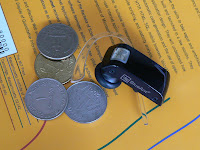
My music collection
is was a strange
mess confluence of ripped cds (using early non-standard rippers), downloaded music from the time of Audiogalaxy, Napster and kazaa. Okay, I pirated "some" music (there I said it) Har. In my defense - I have spent good money on purchasing audio cassettes and CD's and whole albums for just maybe one song. Anyway, that is besides the point. The thing is, I ended up with about 9 Gigs of unsorted disorganized music files. To make things worse I organized and renamed them to suite my tastes long back and ripped all my CDs using some shady ripper. A manual re-organization not only seems infeasible but, an intractable problem. Almost, came to point where decided to delete the whole damn thing in disgust and restart a clean collection.
Problems:
1) Files with wrong names. Some music files just have names track001.mp3, track002.mp3 etc
2) Worse there are actually files in my collection that have the wrong ID3 or empty tags for most fields.
3) Smaller annoying problems, non standard naming of files some with underscores, some with spaces and some just a mess.
4) Folder structure crazy. Some like "I like", "Me Favs 12jul".
SOLUTION: for each file listen to it first. Look up the album on the net and then rename the tags and the files and put them in a proper folder. If I can remember the name of the song that is. Leave aside the question - how does one create a proper folder structure. And all this manually.
Pulling my hair with both hands and shouting Aaaaaah.....
But, just then the sun rose, the birds chirped, the flowers blossomed. Picard to the rescue (strange coincidence, considering how many time the character namesake of the tool has saved the day for the enterprise). It uses
acoustic fingerprinting (equivalent of listening) during scanning of every song, then looks up that AudioFingerprint in the Musicbrainz database to figure out the album. Then optionally (using plugin) it can lookup the cover art, do a cross lookup to other music repositories like amazon or just do a google search. Also, it will fix the ID3 tags, rename the file and organize the folders by artists/albums. Optionally you can ask it to move all the files it was able to fix to another directory in well organized structure. Leaving the files that it couldn't look up the fingerprint for in the original place. And boy it is good. Of the 2400 odd files, now, I am only left with about some 400 files. It is so good that it figured out the right album for a files whose ID3 tags and file name I deliberately garbled. Took some time about 1 to 2 hours to sift through all my music.
Now, with what remains you can do a standard lookup based on the current ID3 tags (the screenshot shows what I have left). It will do its best to locate a match and present its findings with a color code ranging from green to red (great match to bad match). You can then visually sift through these. For those files with multiple matches it will present you with a web page allowing you to choose among the various choices.
Then to top it all off - "there's no Price for Awesomeness, or Attractiveness".
MusicBrainz Picard
 From underutilization of "A day in the life" to reaching a point of realization that there are only 24 hrs in a day - is something! But, when that point is reached things need to be optimized, and tasks triaged to fit the day.
From underutilization of "A day in the life" to reaching a point of realization that there are only 24 hrs in a day - is something! But, when that point is reached things need to be optimized, and tasks triaged to fit the day.













